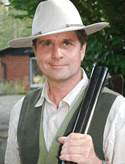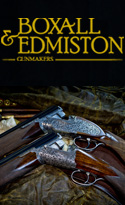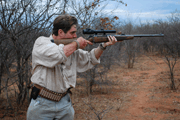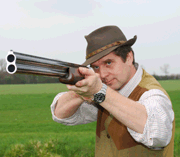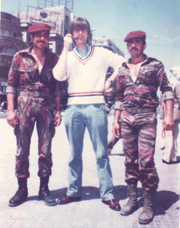Guns and Cartridges For Safari
The guns and cartridges that you might take with you on an African safari is a big subject and everyone has an opinion – including a lot of people without the experience to merit a useful one. So, let me start straight out by saying, that I am not the most experienced safari hunter in the world, but I have been on something over 20 safaris to the Dark Continent and shot most things including problem elephant and buff. I have never shot cats. Nor, is it likely that I will. I would only shoot lion or leopard if they were a threat – but I do not disparage others who do it. I have just decided where I draw my own line. If I shoot a beast it is must be edible, a pest, or, dangerous. I feel comfortable with this and can defend my position to anyone (Richard and Judy included –who once memorably interviewed me on the subject).
Anyway, I digress. What kit do I advise with regard to guns and ammo? Well, I am a pragmatist. I also believe in Murphy’s law – if it can go wrong it probably will. I know of someone who had to call off a hunt in some far flung ex-Soviet ‘stan’ state because his ammunition – a most exotic calibre – got separated from his gun in transit. So, one of my first rules is to stick with popular calibres – ones you might buy or have reloaded locally if the need arose. In Southern Africa these include .470 (at a pinch), .458 Winchester Magnum, .416 Rigby and .375 H&H as far as dangerous game is concerned. The last two being most used these days; .416 and .375 are both popular with pros and sport hunters. .470 (and 500 Nitro Express) are still the expert’s choice for a ‘death or glory’ double rifle, though. One well known film maker favours a .600, but, my own limited experience of it and the .577 is that the recoil is terrible! You don’t tend to do your best shooting with rifles that hurt you. This was one reason why the legendary Karamojo Bell favoured the seemingly underpowered 7x57mm with solids for elephant (I don’t suggest you try it).
What do I use myself for dangerous game? A Paul Roberts built, BRNO/CZ actioned ‘Mauser’ in .458 Lott and a Sako model 85 .375. The big rifle has capacity for an extra round in the magazine (giving you a 4+1 capacity) and a few nice London bells and whistles such as Holland style quick detachable mounts and a barrel band for the sling swivel. It’s a damn good gun when the going gets rough and it saved my neck two years ago in Botswana when I was charged by a tuskless female elephant. They say that the female is usually deadlier than the male, well, there is nothing more aggressive than a tuskless female eli when she gets her metaphorical knickers in a twist. She will, literally, pull your arms, legs, and head, off, and stomp what is left just for the hell of it. Not a good way to go.
The advantage of my Roberts .458, moreover, is that it is built on an action which is very popular in Southern Africa (so one would have a good chance of getting it fixed should something go wrong which is unlikely anyway with Mauser 98 type gun that is well conceived and regulated). The chambering also has a big advantage, because a .458 Lott (which when properly loaded generates no less than 6,000 foot pounds of muzzle energy) will also happily digest normal .458 Winchester Magnum which is much more readily available. I also like the .416 and had one built on a similar action by Paul. The .416 is a terrific killing cartridge with both power and penetration. The .458 Lott, like the .470, is a hammer.
The .375 H&H Sako does not have quite the oomph of the .400s but it has several advantages too. The model 85 is especially well styled with a good stock shape (and there are many other good guns available in the same calibre). The build quality of the standard rifle is excellent and it is very reasonably priced. The action, moreover, is of a semi-controlled feed type which is always useful on a dangerous game tool. A whole variety of bullet weights is available for the .375 from 235 grains to 350. It is a supremely versatile weapon and may – with the right ammunition – shooting anything from elie to springbok. Some police forces in the UK will also license you to use the .375 for red, sika and similar on these shores with expanding ammunition. This is a terrific bonus, because it means you can get hunting experience in the UK with the same rifle you are going to use in Africa. With modern bullets, moreover, such as the Swift A frame (loaded by Remington) and the Trophy Bonded (loaded by Federal) and the bonded soft-nose Oryx which has a reinforced jacket (loaded by Norma), you get the same or better performance than the .400s of yesteryear.
For plains game, my choice is the .300 Win Mag. I have an excellent, old, Tikka 65 which has been re-barrelled by Border Barrels with a stainless tube. It is supremely accurate and very practical. I like the fact that a .300 tends to knock things over – necessitating less wandering around in the bush. That is always a good thing in Africa, especially when you have shot something at dusk and may have difficulty following up a blood trail. Popular plains game calibres in Southern Africa include .308 Winchester (probably the No.1 as here), 30-06, 7mm Rem Mag, .270, 7x57, and .243 (which has a surprising following considering how tough African game tends to be).
One very experienced hunter told me, and I can only echo his advice, “you can’t make up for poor bullet place by using a huge gun.” At the turn of the twentieth, the Boars proved to the British the merits of small calibre weapons. The same plains game pro who preferred the .243 (mind you his was a .243 Musgrave – a cartridge which necks down a .303 British to take the smaller bullet) was also a great advocate of sound moderators for African hunting. He noted five reasons why he usually had one attached to his bolt-action P14.
- Less bang next to your ear
- Less recoil
- It makes it easier to see the bullet strike
- You can hear bullet strike
- In the immediate period after the shot you can hear the quarry running and breaking branches, with a big beast, you may even hear it fall which you cannot do when your ears are ringing form the bang of a big rifle (assuming you are not wearing hearing protection – which I always do).
“On game farms here” he noted, “after the first shot is fired every animal is jittery. It makes it much harder. A silencer negates that completely…and reduces stress levels on other animals…so you might be able to take out several warthog or springbok when you are shooting for meat.” He has a point. As far as bullet weight and type is concerned. I have done well with 180 grain fodder in my .300. I prefer it to a heavier load, because with modern bullets it is flat, fast, and devastating at the terminal end. On my last hunt, I was using Winchester Supreme Silver Tip and was very happy with the results on antelope. I always find Federal and RWS very reliable too. With a .308 I would also advise a 180 grain bullet too with factory loads, but for a different reasons. In this case the extra weight does seem to increase killing power.


